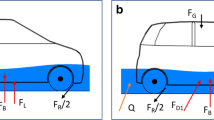Abstract
Vehicles parking on streets or roads can cause various hazards to people and property when they are swept away by urban floods. It is therefore appropriate to investigate the criterion of vehicle stability for such flood conditions, especially for different scenarios and where the criterion of vehicle stability is usually represented by the incipient velocity for the vehicle. In the current study, different forces acting on a partially submerged vehicle are outlined, together with the corresponding expressions of these forces, and a mechanics-based formula of incipient velocity is given for partially submerged vehicles under different orientation angles. About 200 runs of flume experiments were conducted to obtain the conditions of water depth and corresponding velocity at the threshold of vehicle instability for three orientation angles, using two types of die-cast model vehicles at two model scales. Experimental data obtained from the large-scale model vehicles were then used to determine two parameters in the derived formula. Finally, incipient velocities for three vehicle orientation angles were estimated using two different approaches, including predictions using the scale ratios from the small-scale model vehicles and computations based on derived formula using the prototype vehicle parameters. These critical conditions for the prototype conditions, based on the scale ratios, compared well with the calculations obtained using the derived formula, which guaranteed the predicative accuracy of the formula. In addition, the effect of different ground slopes on the vehicle incipient motion was also investigated, using similar experiments and based on the theory of similarity, which indicated that the incipient velocity for a small passenger vehicle on a ground slope of 1:50 was about 25 % lower than the value on a flat ground for an incoming depth of 0.25 m.





Similar content being viewed by others
References
Chanson H (2004) The hydraulics of open channel flow: an introduction (2nd ed). Elsevier Butterworth-Heinemann, Oxford UK
Chien N, Wan ZH (1999) Mechanics of sediment transport. American Society of Civil Engineers, Reston VA
Cox RJ, Ball EJ (2001) Stability and safety in flooded streets. In: Proceedings of conference on hydraulics in Civil Engineering. The Institution of Engineers, Barton Australia, pp 239–248
Defra and Environment Agency (EA) (2006) Flood and Coastal Defence R&D Programme, R&D outputs: Flood Risks to People (Phase 2 Project Record, FD2321/PR). <www.defra.gov.uk/environ/fcd/research>
Environment Agency (2004) Living with the risk: the floods in Boscastle and North Cornwall on 16 August 2004. Environment Agency Report, Exeter
Gerard M (2006) Tyre-road friction estimation using slip-based observers. Master thesis. Department of Automatic Control, Lund University, Lund Sweden
Gordon AD, Stone PB (1973) Car stability on road floodways. Technical Report 73/12. University of New South Wales, Manly Vale, Australia
Keller RJ, Mitsch B (1993) Safety aspects of design roadways as floodways. Research Report No. 69. Urban Water Research Association of Australia, Australia
Shand TD, Cox RJ, Blacka MJ, Smith GP (2011) Appropriate safety criteria for vehicles: Literature Review (Stage 2). Report Number P10/S2/020. Australian Rainfall and Runoff (AR&R), Manly Vale, Australia
Shu CW, Xia JQ, Falconer RA, Lin BL (2011) Incipient velocity for partially submerged vehicles in floodwaters. J Hydraul Res 49(6):709–717
Teo FY, Xia JQ, Falconer RA, Lin BL (2012) Experimental studies on the interaction between vehicles and floodplain flows. Int J River Basin Manage 10(2):149–160
Wu WM (2007) Computational river dynamics. Taylor and Francis Group, London
Xia JQ, Teo FY, Lin BL, Falconer RA (2011) Formula of incipient velocity for flooded vehicles. Nat Hazards 58(1):1–14
Zhang RJ, Xie JH (1993) Sedimentation research in China. China Water and Power Press, Beijing
Acknowledgments
The study reported herein was conducted as part of the Research Exchanges with China and India Scheme, supported by the Royal Academy of Engineering, UK. It was also partly supported by the National Natural Science Foundation of China (Grant No. 51379156 and 51079103) and the Research Fund for the Doctoral Programme of Higher Education Institutions of China (Grant No. 20120141110011).
Author information
Authors and Affiliations
Corresponding author
Rights and permissions
About this article
Cite this article
Xia, J., Falconer, R.A., Xiao, X. et al. Criterion of vehicle stability in floodwaters based on theoretical and experimental studies. Nat Hazards 70, 1619–1630 (2014). https://doi.org/10.1007/s11069-013-0889-2
Received:
Accepted:
Published:
Issue Date:
DOI: https://doi.org/10.1007/s11069-013-0889-2




